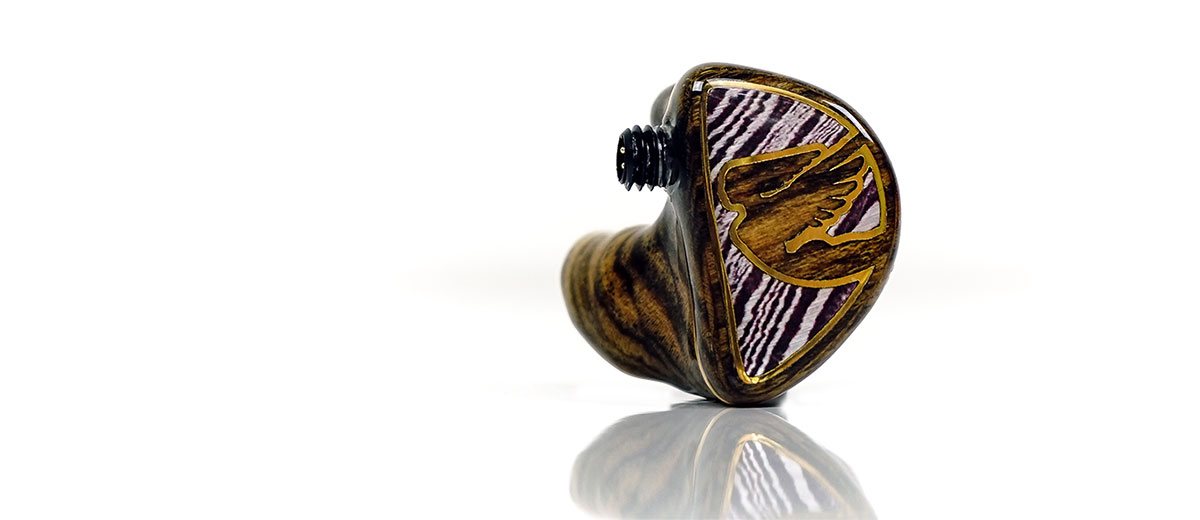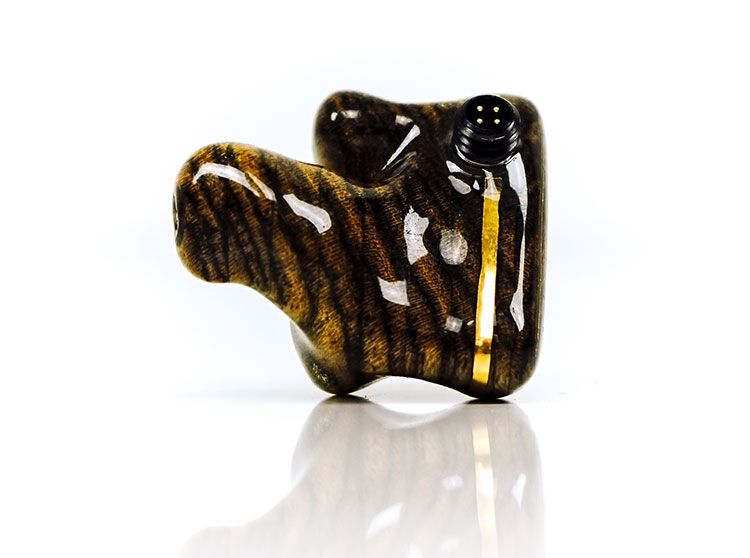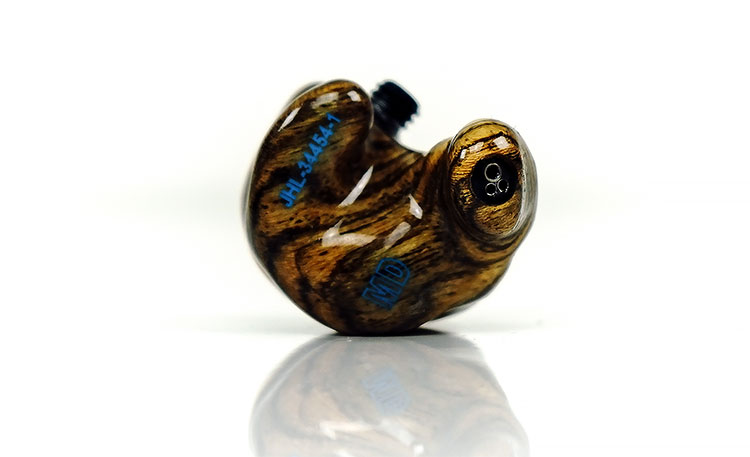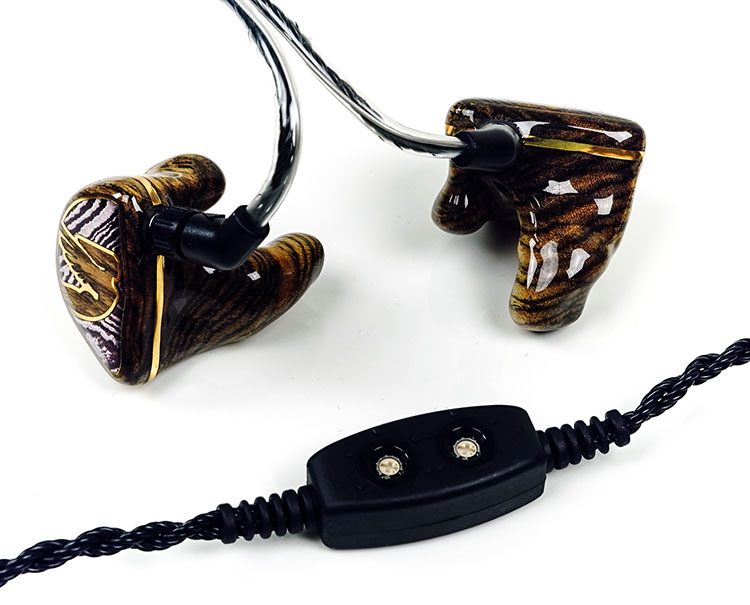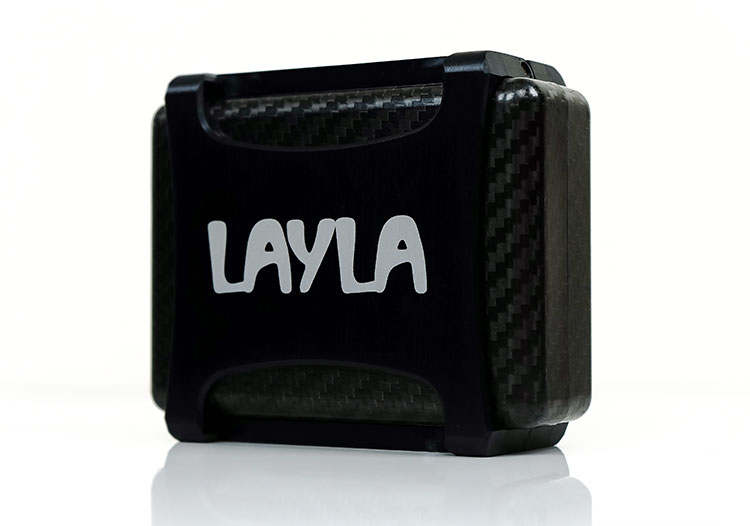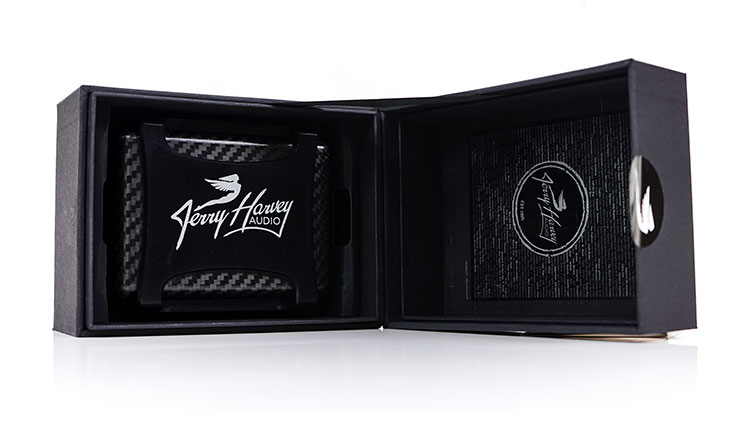Meet The Layla Luthier Edition
Design
The Layla is perhaps one of the biggest CIEMs I have ever received. There are pros and cons to that but from a design perspective, a larger CIEM makes a better display of design prowess than smaller units. And let me tell you, the Luthier edition is the best design I have ever received for a custom monitor period.
The bar was set very high last year with the heartwood inserts VE8 from Vision Ears and the “Avatar” colors of the FIBAE 3 from Custom Ears. Both are intricate and beautiful in their own right. However, for sheer opulence, intricacy and just being so darn original I doff my cap to JH Audio. Wood plates are one thing, but a layered wood shell is quite another.
Bacote Wood
The shell is a layered construct made from a rather expensive Bacote wood. This is a Central and South American timber known for its striking yellowish-brown and black strip grain.
The colors tend to darken even more as you age the wood so I presume the Bacote wood used here is a little matured because it is more tan and black with a hint of yellow running through it. Bacote wood is also known to be fairly durable and easy to turn and work with. Importantly, Bacote is not an endangered species of wood so it is not an unethical material to use.
Now Bacote wood is not known to be a super-strong wood like oak or rosewood. However, the JH Audio team has layered the Bacote in such a way to extract maximum flexibility in shaping it to duplicate my ear impressions yet retain a level of durability needed for a CIEM. No two shells will be unique, that is the joy of working with wood so left and right will not be exact duplicates.
Finishing
The resulting shells have striking zebra-like contrasts and bold figuring throughout with a rich organic tone of tans and blacks. The shell is finished with a gold trim just below the Damascus faceplate and a hypoallergenic clear coat for a nice level of shine.
The trim goes all the way around as well as the outline of the faceplate and the white FlyGirl logo in the middle. It is an excellent complimentary warm tone to the overall final look.
Note, that the retail online customizer for the Luthier edition will default to titanium faceplates without the Damascus artwork and gold trim. If you want to switch to the subtler titanium plats with the Damascus artwork and gold trim then drop the JH Audio team an email first.
I personally think the Damascus artwork plate is a better match and more in sync with the bolder lines of the Bacote grain but beauty is always in the eye of the beholder.
Nozzle
The Layla Luthier edition uses a tri-bore nozzle design and it is a fairly bulbous nozzle at that. The three tubes I cover the low-end, mids, and treble bands with the slightly larger tube for highs. Just check and make sure your tubes are clean and clear before using them as the two smaller ones could get clogged easily with wax and other contaminants if left unchecked.
Cables & Connectors
The Layla comes fitted with a black 4-pin male threaded socket and is pretty much standard on a lot of JH Audio’s top-end CIEMs and universal variants. I am used to them on the Roxanne and to some extent on the Mason V3 from UM and I do think they are much more durable and easier to work with than 2-pin or MMCX.
They are a little bulkier though than 2-pin or MMCX but relatively unobtrusive when using them due to the gentle 120-degree over-the-ear slant of the connector barrel.
The cable supplied is JH Audio’s 49″ 8-wire OFC cable designed in partnership with Moon Audio. Thank you for not resorting to Plastics One cables! The top end is terminated with the 4-pin connectors and on the other end is a super chunky and durable hard plastic barreled right-angle 3.5mm jack. The strain relief on this is amazingly strong looking.
The y-split is finished with the same materials only on a smaller scale with a similarly excellent level of strain relief. There is some transparent memory wire overlapping the cable at the top for shaping and a fairly basic plastic black tubing for a cinch.
The cable handles really well actually. No tangling, zero memory retention, and low to zero microphonics.
Variable Bass Module
One of the hallmarks of a JH Audio creation is their variable bass module which primarily raises the low-end by a maximum of 13dB up to 60Hz in each left and right channel independently. The module also tweaks the rest of the response by around 2-4dB depending on which setting you choose so this is not all about the low-end though it is the predominant area affected in terms of magnitude.
You can tweak your settings with the small blue screwdriver supplied and I do recommend you match the left and right at all times so as not to skew the presentation. The module does have tiny little markers to help you line them up precisely on each dial.
Comfort & Fit
The Layla is a chunky monkey which is why it is important to get a complete ear impression over too them. It is the biggest CIEM I have received and I do wonder why a little.
Perhaps the 4th order crossover network combined with the 4-pin socket combined with the chamber design adds a lot of the girth. The net result is you will feel it in your ear a little in terms of size and to a lesser extent, weight.
That being said, the fit is very good, with no issues with accuracy but it is on the larger side than a 64 Audio fitting and much tighter than the UM fittings. I tend to call these ‘pro-fits’, ones where stage artists tend to go for because they will not fall out and there is a lot of open-jaw movement when singing which breaks the seal on looser fittings.
With regards to pressure then you will find them a bit tighter in the canals than the shorter UM or an AAW variant (Mason v3 and W300AR). These are two of my most relaxed fittings. The Layla is similar in depth to the Lear BD4.2 though a bit wider. The seal is excellent though, with absolutely zero leakage both in and out.
Sound Impressions
Summary
The Layla is a full-bodied and smooth-sounding monitor with a natural to slightly warm sounding tonality and a fairly spacious soundstage with a ton of depth. The bass module will have an impact on the response in a few different ways and it is not all focused on the low-end.
Neutral
In its most neutral position, which is the one I actually settled on in the long run, you get a fairly flat and linear response right up to 1k though by no means whatsoever is this a thin or sterile sound.
It still retains a beautiful level of texture and detail and it never overpowers the vocal presence which is an area I am always cautious about if the low-end is naturally meaty. Not so with the Layla, both are clear and well separated though they do tend to favor vocal pitching closer to 1k than 2-3k where there is a slight dip.
12’Oclock
Throw the bass module up to 12 o’clock and the presentation becomes a little thicker with more sub-bass energy by up to 6dB. However, this is not a pure bass boost. The 1k, 3k, and 7k elevations in the Layla response stay fairly well elevated and clear sounding.
2 o’clock
For the neutral lover, this is likely as far as you want to go, though for musicality fans I think most can stretch to around 2 o’clock on the module which is elevated by another 2-3dB in its sub-bass bias.
Curiously the 2pm position is perhaps the most relaxed-sounding in the mids and treble and you might the staging of the Layla loses a little height and air. The low-end on the other hand is now more powerful, punchier with a perceptible increase in depth though a touch slower sounding.
4 o’clock
Full-on, or 4 o’clock is another 6-7dB additional on the low-end with a particular emphasis on the sub-bass elevation where you will find the entire 6dB increase up to 60Hz. The power is immense for a BA driver design and you will feel the full force of that quad BA design when you push up the bass to its maximum.
Things tighten up by 500Hz where surprisingly the bass module maybe adds about 1dB emphasis on the 1.5k, 3k, and 7k bumps over and above the 2pm profile. A little bit of the loudness principle there because you really do not want the low-end to veils over the vocals and darken the experience too much.
It is slower sounding than flat or neutral but, to my liking, the transient response was still clear and quick enough to prevent the mids from sounding overly thick or smoothed over. The Layla retains impressive separation and clarity despite the heavy-hitting sub-bass power.
Soundstage
The staging on the Layla has been shaped to convey depth and power. Even in the neutral setting, linear and flat as it is there is still impressive rumble and body right up to 1k. JH Audio has tuned the Layla to be a fairly open and spacious sound though the top-end does lack a bit of sparkle and air in comparison to other leading IEMs.
You do get a slightly darker sound in comparison to say an A18 but it does throw out huge depth and width so instrumental separation and clarity are actually excellent. Instrumental positioning, especially lower mids pitched or lower is relatively neutral in positioning with a slightly forward vocal presence around 1k to ensure nothing gets veiled over or lost in the mix.
If you are pushing up the bass dial the thickness and relative forwardness of the instruments are enhanced but only marginally so.
You will also find the highest bass position, 4 o’clock, to have a higher 3k and 7k peak than the 2pm position which provides for a nuanced level of contrast and sparkle. Neutral and 12 o’clock positioning, however, will pull back a bit in-depth and provide more emphasis on width and slightly more height on the Layla.
Bass
Really even and linear sounding without additional variable bass input but also without any of the usual post 250Hz dips into the lower mids. As a result, you get a very coherent low-end and a smooth transition from the mid-bass into the lower mids.
Without the lower mids dip (in fact, it rises from 800Hz-1.5k) you do get some additional warmth and body into lower-pitched instruments so the sound is relatively forward and full sounding rather than neutral and clean.
The most impressive aspect of the Layla bass is its level of control. Despite the abundance of texture and detail, it is not flabby or soft sounding at all, rather it is quite natural in tone though a mite slower than the likes of the VE8 and A18.
Actually, it is probably one of the few BA low-end tuning’s that come closest to that “dynamic driver” sound in terms of the body, decay, and depth. Even when pumped full of 13dB, which targets more the sub-bass and the power side of the presentation than the mid or upper bass, it still sounds very much in control.
Mids
There is a significant elevation around 1k with the rise starting around 800Hz then a drop of about 3-4dB around 1.5k to 2k and another rise of 2-3dB in the upper mids around 3k.
This is a smooth-sounding presentation with a slight even harmonic order to Layla’s timber. It is also a fantastic sounding monitor for my 80’s rock and modern AOR midrange rhythm guitar work.
The bumps also favor vocal and presence regions pushing them a little further forward in positioning over the rest of the stage. It is not significant enough for vocals to sound overly shouty or edgy and there isn’t a huge amount of treble forwardness to tip the harmonic balance into something sharp or edgy sounding.
As such vocals, particularly male vocals, are full-bodied and detailed sounding but still very natural and sibilant free. Higher pitched vocals that fall beyond the 1-1.5kHz will fall back slightly and seem a touch more distant in the mix. I tended to find this positioning more relevant to the likes of Enya when she starts hitting her upper register around C4 and E5. However, for female vocalists that power through their belting range such as Beyonce, the Layla delivers a full and clean with a resonant sound.
Midrange percussion work does take a back step behind vocals though with a fairly muted 4-6k range on the Layla. You get some nice weight in cymbal work but there isn’t quite enough 3rd order presence for bite and contrast.
Treble
The Layla is on a gentle but downward curve pretty much from 1.5kHz onwards. You get a nice bump at 3kHz and again at 7kHz and your final “hi-fi” nudge around 12k but each is less than the one that precedes it so it is not an overtly forward or bright top-end signature.
All elevations are designed to just gently lift the treble with some sparkle so it doesn’t sound overly dark or attenuated, especially when the bass boost is activated.
However, at the same time, the Layla tuning injects some excellent body and a natural tone into its treble signature that gives everything a relatively realistic sound, especially when set to neutral. Sibilance is non-existent for me in pretty much every decently recorded track or even bright sources.
Treble freaks might find the sound overly rounded and even-harmonic biased despite the excellent level of detail. I get that but I do tend to personally prefer a natural treble sound to an overly peppy and forward signature these days so your YMMV.
Click on Page 3 below for Pairings & Comparisons

